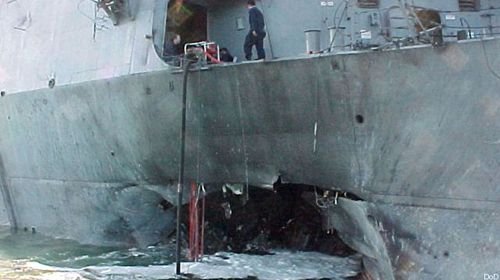Invisible handcuffs stop terrorism at sea
The destroyer USS Cole suffered a large hole after being attacked at sea.
On October 12, 2000, one of the US Navy’s most modern warships, the Arleigh Burke-class destroyer USS Cole, was attacked by the terrorist organization al-Qaeda with a suicide bombing.
At that time, the ship was arriving at the port of Aden, Yemen to refuel.
After refueling, the sailors on the USS Cole were resting when they suddenly discovered a fishing boat slowly approaching the US warship, then accelerated and detonated 300 kg of explosives.
This is the heaviest loss of the US Navy since the accidental shooting of the destroyer USS Stark in 1987, when the Iran-Iraq war was breaking out.
Although the USS Cole was fully armed, the soldiers watched helplessly as the fishing boat carried out the attack.
The incident raises the need for a weapon that does not cause injury but must be very effective to prevent dangerous attacks.
To meet this need, military technicians have designed LRAD – Long Range Acoustic Device.

A sonar weapon system used to neutralize enemies at sea.
When operating, LRAD can emit a sound intensity of up to 155dB, enough to give any normal person a headache.
With this design, the LRAD system can emit a sound wave that exceeds the `pain threshold` of the human ear within a range of 500 meters, followed by a warning to deter or prevent extreme actions.
The LRAD system has been installed on US naval ships patrolling the port of Basra, Iraq, to contact and warn ships traveling around oil facilities, with a warning range of up to 1,000 meters.
On November 7, 2005, LRAD was used for the first time to prevent a pirate attack on the luxury passenger ship Seabourn in waters 160 km off the Somali coast.
Phodio, a company specializing in distributing LRAD products in the UK, said this type of sonic weapon has been used for many years on naval ships, in anti-piracy campaigns and to disperse protesters or rioting crowds.
Causing discomfort but not causing damage, LRAD is suitable for the task of preventing terrorist and sabotage activities like what happened to the USS Cole in 2000.














Post Comment